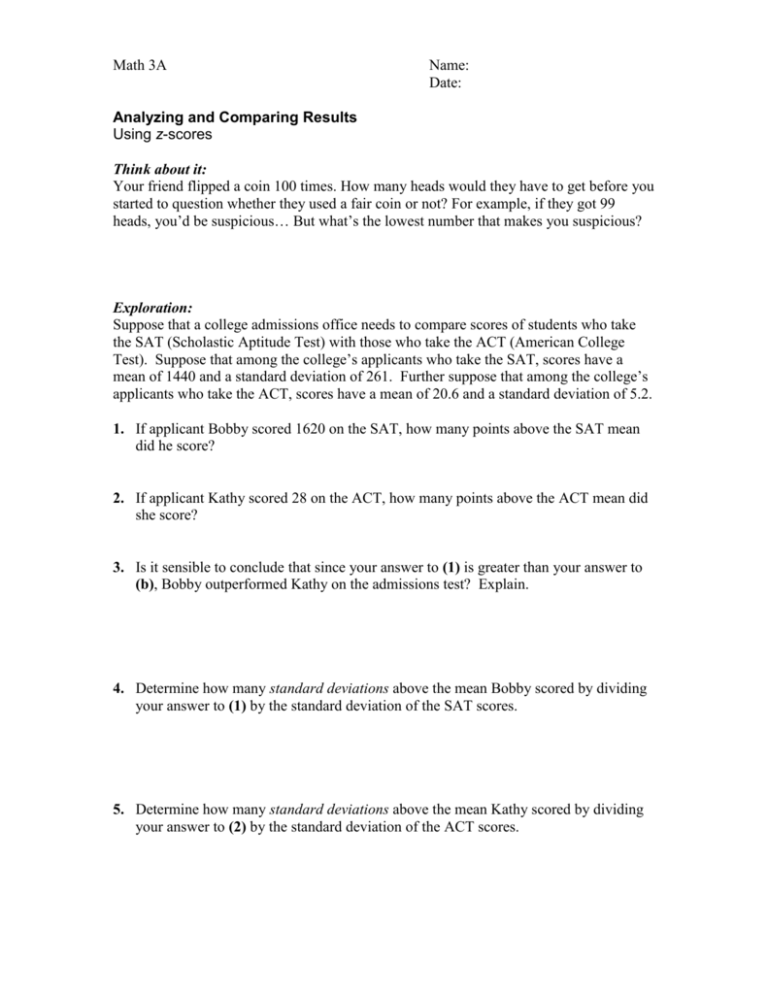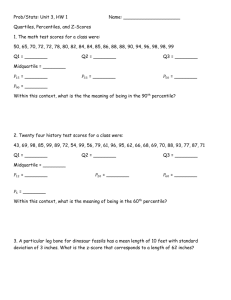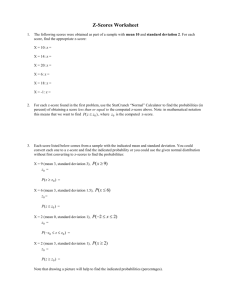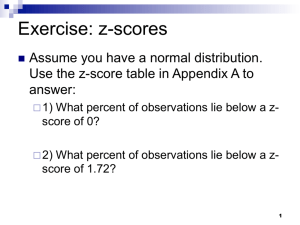150603 z-scores
advertisement

Math 3A Name: Date: Analyzing and Comparing Results Using z-scores Think about it: Your friend flipped a coin 100 times. How many heads would they have to get before you started to question whether they used a fair coin or not? For example, if they got 99 heads, you’d be suspicious… But what’s the lowest number that makes you suspicious? Exploration: Suppose that a college admissions office needs to compare scores of students who take the SAT (Scholastic Aptitude Test) with those who take the ACT (American College Test). Suppose that among the college’s applicants who take the SAT, scores have a mean of 1440 and a standard deviation of 261. Further suppose that among the college’s applicants who take the ACT, scores have a mean of 20.6 and a standard deviation of 5.2. 1. If applicant Bobby scored 1620 on the SAT, how many points above the SAT mean did he score? 2. If applicant Kathy scored 28 on the ACT, how many points above the ACT mean did she score? 3. Is it sensible to conclude that since your answer to (1) is greater than your answer to (b), Bobby outperformed Kathy on the admissions test? Explain. 4. Determine how many standard deviations above the mean Bobby scored by dividing your answer to (1) by the standard deviation of the SAT scores. 5. Determine how many standard deviations above the mean Kathy scored by dividing your answer to (2) by the standard deviation of the ACT scores. This activity illustrates the use of standard deviation to make comparisons of individual values from different distributions. One calculates a z-score, or standardized score, by subtracting the mean from the value of interest and then dividing by the standard deviation. These z-scores indicate how many standard deviations above (or below) the mean a particular value falls. value - x z - score = s 6. Use the z-scores you calculated in (4) and (5) to decide which applicant performed better on his or her admissions test. ~~~~~~~~~~~~~~~~~~~~~~~~~~~~~~~~~~~~~~~~~~~~~~~~~~~~~~~~~~~~~~~~~~ Another use of z-scores Think back to the question about 100 coin flips. How can we use the normal distribution to decide what a good cutoff might be? -s -3s -2s x +s +3s +2s Example: Is getting 62 heads when flipping 100 coins an unusual result or fairly typical? Practice 1. a. Calculate the z-score for applicant Peter, who scored 1110 on the SAT, and for applicant Susan, who scored 19 on the ACT. Refer to page 1 for x and s . b. Who did better on their test? Use z-scores to make your decision. 2. Under what conditions does a z-score turn out to be negative? 3. a. A student scored 65 on a math test that had a mean of 50 and a standard deviation of 10. Calculate her z-score for the math test. b. She scored 30 on a history test with a mean of 25 and a standard deviation of 5. Calculate her z-score for the history test. c. On which test did she do better? Use z-scores to make your decision. 4. Sara and Becca are very competitive. They both run track but compete in different races. a. Sara ran the 100-yard dash and had a time of 10.5 seconds where the overall mean was 11 sec and standard deviation was 0.4 seconds. Calculate her z-score. b. Becca ran the 1-mile and had a time of 6.8 minutes where the overall mean was 7.3 minutes and standard deviation was .6 minutes. Calculate her z-score. c. Who performed better? Use z-scores to make your decision but remember, better runners have lower times. Reminder for the following problems: (remember this is a repeated experiment) 5. You flip a coin 36 times. a. Find the mean, variance and standard deviation for the number of heads. x= s2 = s= b. Your result is 10 heads. Calculate the z-score for this result. c. Is it unusual to only get 10 heads? Use the z-score to decide. 6. You roll a number cube 360 times and count the number of twos. a. Find the mean, variance and standard deviation for the number of twos. x= s2 = s= b. Your result is 25 twos. Calculate the z-score for this result. c. Is it unusual to only get 25 twos? Use the z-score to decide.







